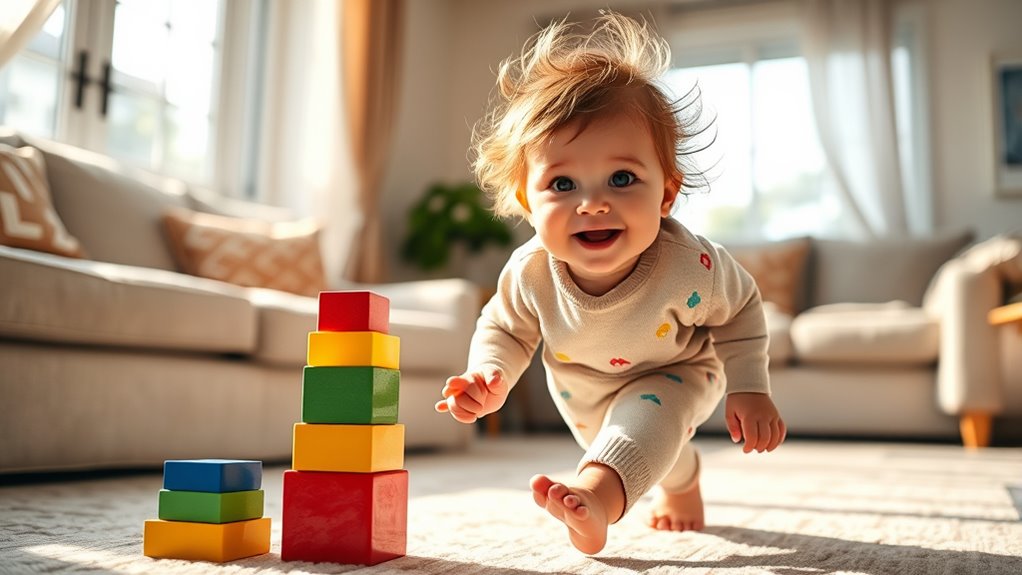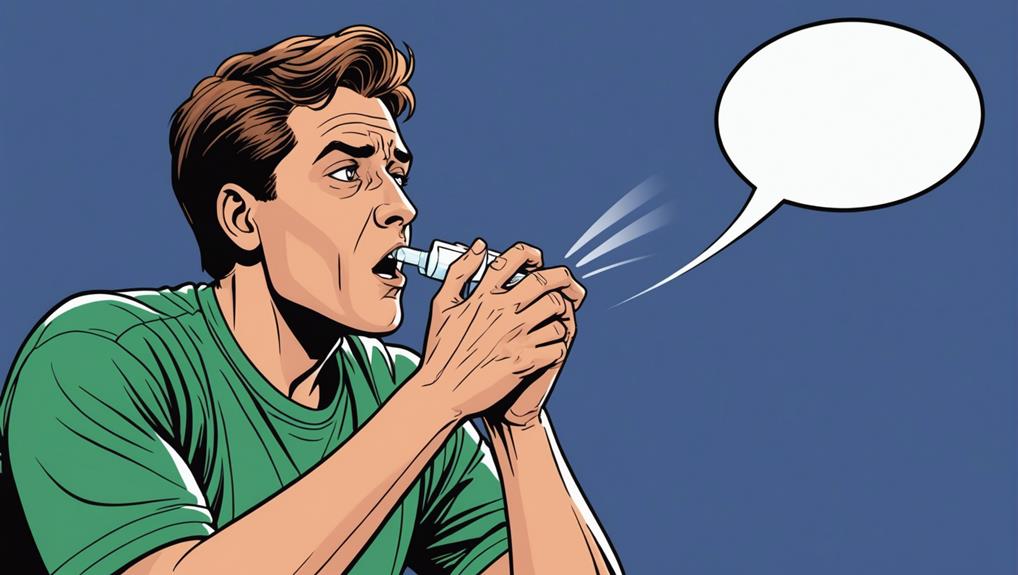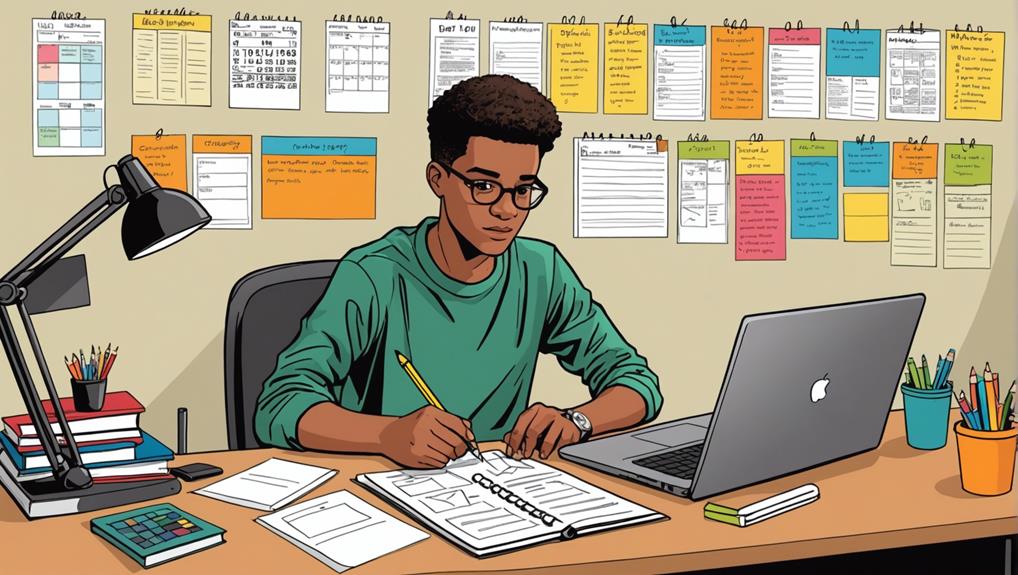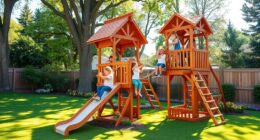Between 12 and 18 months, your child starts recognizing their first words, expands their vocabulary, and begins imitating sounds and gestures. They understand simple commands, use non-verbal cues like pointing, and play peekaboo to grasp object permanence. Your little one also explores enthusiastically, climbs, and develops coordination. Supporting these skills helps build confidence and independence. If you keep exploring, you’ll discover ways to encourage each exciting step of their growth and learning.
Key Takeaways
- Toddlers recognize and respond to early words like “mama” and “dada,” expanding their vocabulary rapidly between 12 and 18 months.
- They develop motor skills such as walking, climbing, and hand-eye coordination through safe exploration and play.
- Object permanence emerges as children understand objects exist even when hidden, shown through peekaboo and searching activities.
- Communication advances with gestures, non-verbal cues, and responding to simple commands, laying the foundation for language skills.
- Social skills grow as toddlers imitate actions, share toys, and engage in interactive play and peer interactions.
Recognizing the First Words
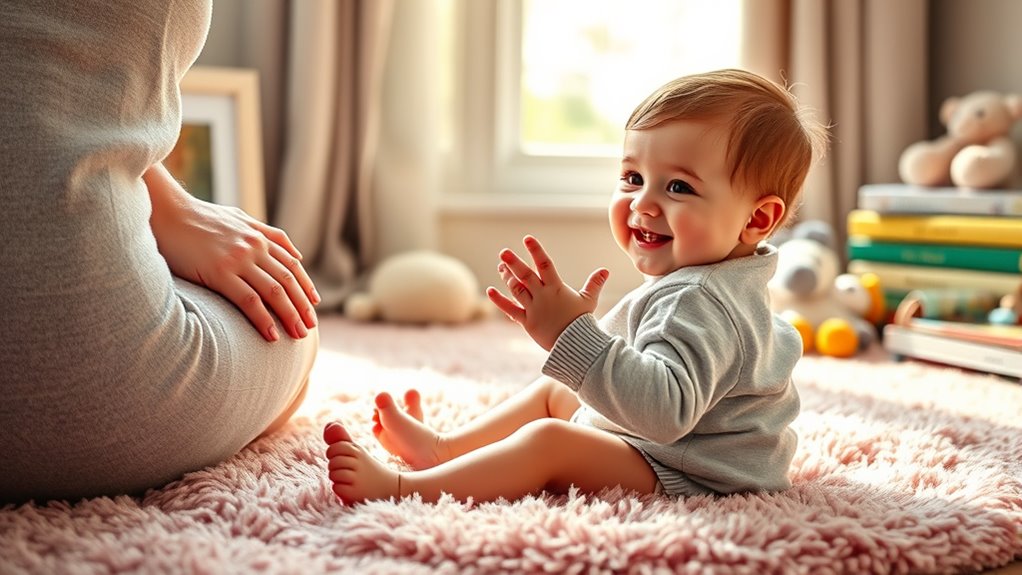
By around 12 months, many toddlers begin to recognize their first words. This milestone is a big step in language development, showing that your child is making important connections between sounds and meanings. During this stage, sensory exploration plays a key role, as your little one interacts with their environment through touch, sight, and sound. They start to associate specific words with familiar objects or people, often responding with excitement or gestures. Your child’s ability to recognize words indicates growing cognitive skills and memory. You might notice them turning toward a familiar name or pointing to objects when they hear certain words. This early recognition helps lay the foundation for future language skills, boosting their confidence in communicating with you and others. Additionally, engaging with early language development activities can support their ongoing progress and comprehension, which is essential for overall cognitive growth.
Expanding Vocabulary and Imitation Skills
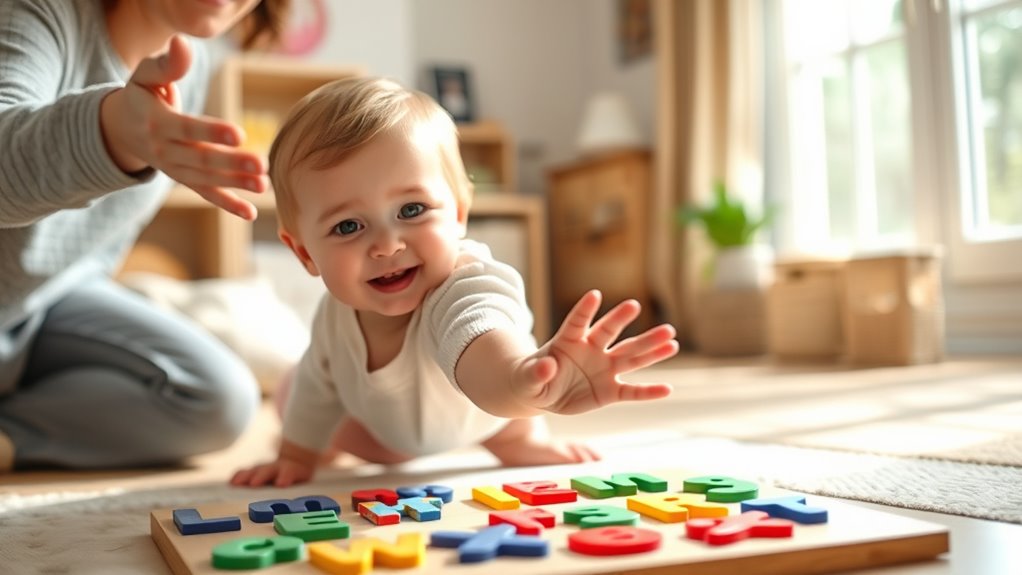
As your toddler approaches 12 to 18 months, they begin to expand their vocabulary rapidly and imitate a variety of sounds and actions they observe. This stage marks significant progress in speech development, as they start associating words with objects and people around them. Their language milestones include saying simple words like “mama” or “dada” and experimenting with new sounds. Imitation plays a key role here; your child copies gestures, facial expressions, and speech patterns. By repeating sounds and words, they build a foundation for more complex language skills. Encouraging their efforts by talking, reading, and singing supports their expanding vocabulary and helps them develop confidence in communication. This stage sets the stage for more advanced language skills in the coming months. Additionally, engaging in imitation skills can significantly enhance their ability to learn and mimic new words and actions more effectively.
Understanding Simple Instructions
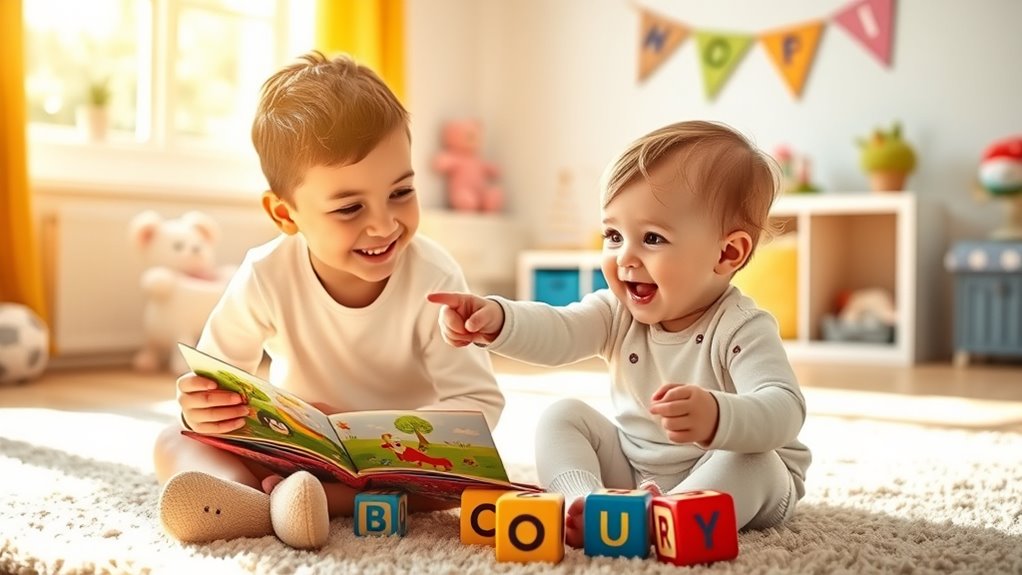
At this age, your child starts recognizing simple commands like “come here” or “give me the toy.” They often respond by acting appropriately or using gestures such as pointing or nodding. Paying attention to these cues helps you understand their growing ability to follow directions. Being aware of their aquatic exercise can also be useful as they begin to understand routines related to bathroom use. Additionally, introducing them to water safety rules and simple water activities can support their overall development. Incorporating goal setting techniques can help you track their progress and celebrate milestones as they develop new skills.
Recognizing Simple Commands
Around 12 to 18 months, your child begins to understand simple commands, marking a key milestone in their language growth. They start recognizing gesture cues and responding to verbal commands like “sit,” “come,” or “give me.” This shows their ability to connect words and actions. To encourage this skill, use clear, consistent gestures alongside spoken words. You can also create routines that reinforce understanding. Here’s a quick guide:
| Command | Gesture Cue | Example Scenario |
|---|---|---|
| “Wave” | Waving hand | Saying “bye-bye” while waving |
| “Sit” | Hand on floor | Asking them to sit during play |
| “Come” | Open arms | Calling them to come over |
| “Give” | Outstretched hand | Asking for an object |
| “No” | Finger wagging | Correcting behavior |
Your child’s ability to recognize simple commands will grow quickly with practice. Incorporating interactive toys can further enhance their understanding of commands and gestures, especially as they begin to associate visual cues with spoken instructions. Recognizing that language development is influenced by both environmental and social factors can also help you tailor your approach to support their progress.
Responding Appropriately
Once your child begins to recognize simple commands and gestures, they start responding appropriately by acting on what they’ve heard. This stage marks an important step in language development, showing they understand more than just words—they grasp the intent behind them. As they respond, you’ll notice emotional responses that reflect their growing awareness and comfort with communication. They might smile when asked to give a toy or look confused if they don’t understand. Consistent, clear instructions help reinforce this understanding, encouraging your child’s confidence and independence. Responding appropriately also involves emotional cues, like noticing your tone and expressions, which help your child interpret and react correctly. This milestone sets the foundation for more complex language skills and emotional connections later on. Recognizing and responding to simple instructions supports early learning, especially when paired with positive reinforcement, and helps build a trusting relationship between you and your child. Additionally, understanding the benefits of positive reinforcement can motivate your child to continue engaging with your instructions and foster a supportive learning environment.
Using Gesture Cues
Using gesture cues is a powerful way to help your child understand simple instructions, especially as they begin to grasp non-verbal communication. Children often respond well to visual signals before they fully develop verbal skills. By incorporating gesture cues, you teach them to interpret signs like pointing, waving, or nodding. This encourages early comprehension and builds a foundation for language development. Here are some effective ways to use gesture cues:
- Point to objects or places to direct attention.
- Use waving or nodding to confirm understanding.
- Combine gestures with words for clearer communication.
- Be consistent, so your child learns to associate gestures with actions.
- Using visual aids like picture cards or visual aids can further enhance understanding and reinforce the connection between gestures and meaning. Additionally, understanding non-verbal communication is essential for fostering effective interactions and supporting your child’s social skills.
Mastering gesture cues enhances your child’s ability to understand simple instructions and strengthens their non-verbal communication skills.
Using Gestures to Communicate
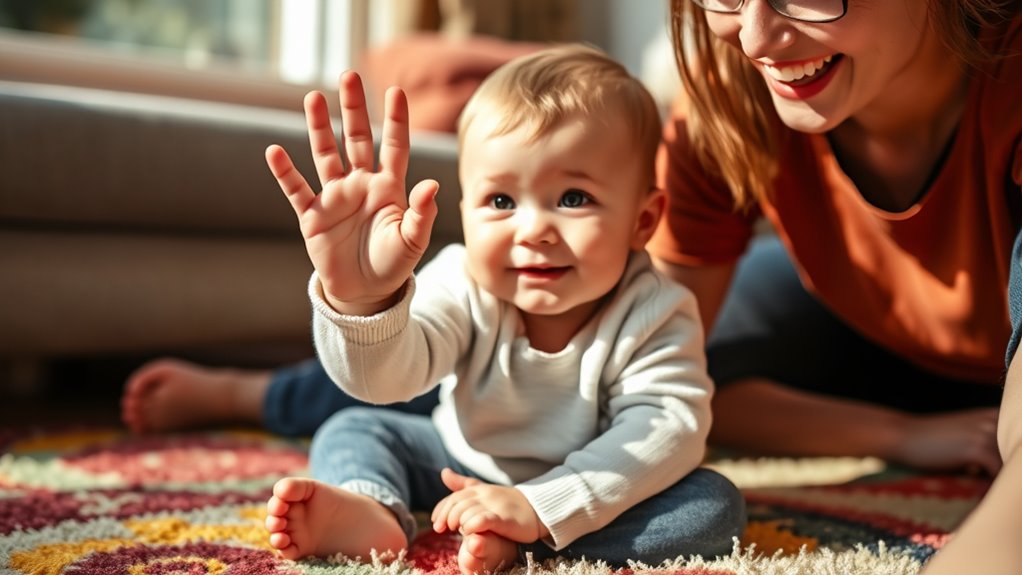
As your toddler approaches 12 to 18 months, they often begin to use gestures to communicate their needs and interests. Gestural communication helps them express feelings without words, relying on nonverbal cues to get your attention. You’ll notice pointing, waving, or reaching as common signals. To support this, encourage your child to use gestures by modeling and responding positively. Here’s a quick guide to common gestures:
| Gesture | Meaning | Example |
|---|---|---|
| Pointing | Wanting attention or object | Pointing at a toy they want |
| Waving | Hello or goodbye | Waving when you leave or arrive |
| Reaching | Asking for something | Reaching for a snack or toy |
| Nodding | Yes or agreement | Nodding to show understanding |
| Shaking head | No or disagreement | Shaking head to decline |
Developing Object Permanence
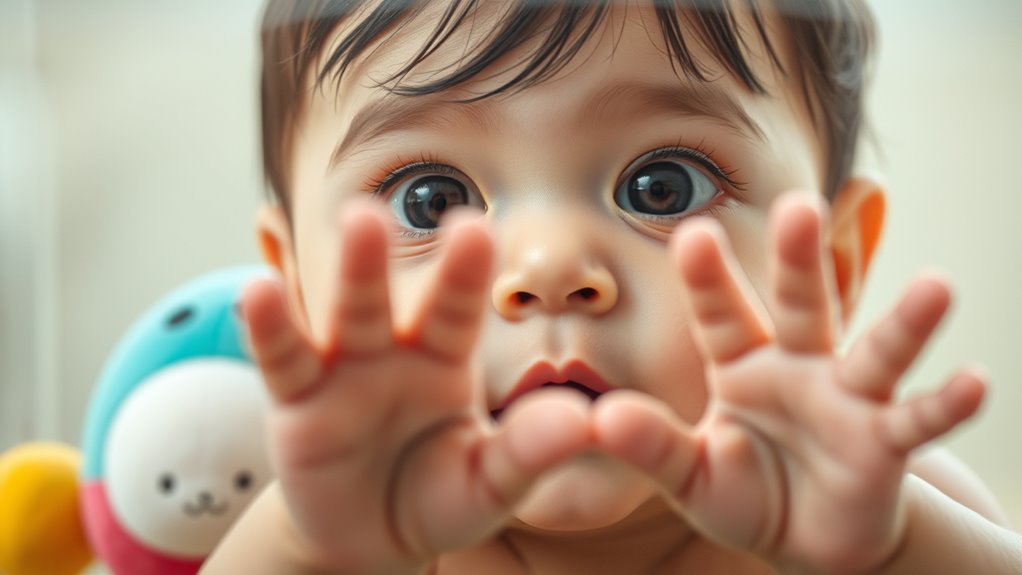
At this stage, your child starts to understand that objects still exist even when they can’t see them. They might enjoy games like peekaboo and look for hidden items around the house. This is a key step in developing their understanding of object permanence. Incorporating concepts like self watering plant pots can also help improve their ability to recognize and respond to familiar words and sounds. Additionally, engaging with AI advancements can provide new opportunities for interactive learning and cognitive development.
Recognizing Hidden Items
Have you ever wondered how your toddler begins to understand that objects continue to exist even when they’re out of sight? At this stage, they start recognizing hidden items, a key part of developing object permanence. This means they’re learning to search for items even when they’re covered or out of view. To encourage this, you can:
- Name household objects like keys or cups when hidden behind your back.
- Play simple games that involve hiding toys and asking them to find the hidden item.
- Identify common animals in books or pictures, even if they’re temporarily out of sight.
- Use peekaboo to help them understand that things and people still exist even when hidden from view.
- Understanding the horsepower of electric dirt bikes can also serve as a fun way to introduce them to concepts of energy and motion as they grow older.
This stage helps them understand that objects and familiar faces continue to exist beyond their immediate sight.
Playing Peekaboo Games
Playing peekaboo games is a fun and effective way to strengthen your toddler’s understanding that objects and people still exist even when out of sight. This activity boosts peekaboo engagement by encouraging your child to anticipate and respond to your hiding and revealing. You can try various game variations, like hiding behind a blanket, peeking from around a corner, or covering your face with your hands. These different approaches keep the game exciting and help your child grasp the concept of object permanence. As your toddler anticipates the reveal, they develop confidence in understanding that what’s hidden still exists. Keep the tone playful and encouraging, making peekaboo a favorite part of your daily interactions.
Understanding Object Permanence
How does your toddler begin to understand that objects and people continue to exist even when out of sight? This is part of developing object permanence, a key milestone in cognitive development. As your child explores, they start realizing that hidden objects still exist.
Here are some ways this develops:
- They look for toys hidden under a cloth.
- They check behind furniture for a missing item.
- They understand that people leave and return.
- They anticipate where a toy might be after it’s covered.
These behaviors show their growing understanding that objects aren’t gone forever, just out of view. This milestone marks essential progress in their cognitive development, helping them build memory and problem-solving skills.
Improving Fine Motor Skills With Hand Movements
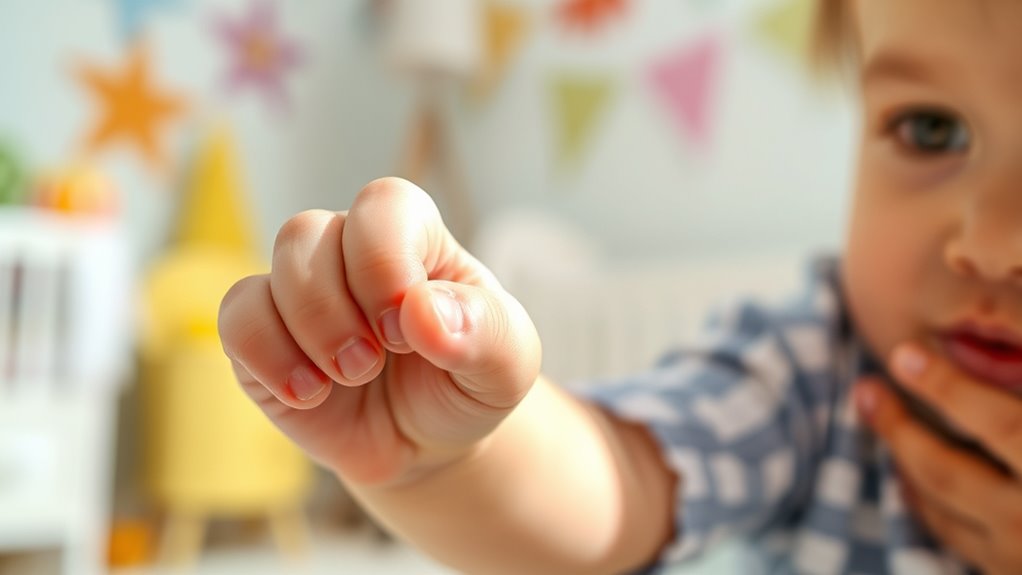
At this stage, your child is becoming increasingly skilled at coordinating hand movements, which is essential for tasks like grasping, pointing, and manipulating objects. Focus on activities that promote hand grasping and finger isolation, such as picking up small items or turning pages. These actions strengthen fine motor skills and prepare your child for more complex tasks. To illustrate, here’s a helpful breakdown:
| Skill | Example Activity | Developmental Benefit |
|---|---|---|
| Hand grasping | Picking up blocks | Improves grip strength |
| Finger isolation | Pointing at objects | Enhances finger control |
| Pincer grip | Picking small toys | Builds precision and dexterity |
| Stacking blocks | Creating towers | Develops coordination |
| Turning pages | Book reading | Strengthens finger movements |
Encourage playful practice to support steady progress. Additionally, engaging in activities that improve fine motor skills can greatly enhance your child’s overall development.
Taking First Independent Steps

As your child develops better hand coordination and control through fine motor activities, they become more ready to take their first independent steps. This milestone marks significant motor skill development and often results from their growing confidence through sensory exploration. You’ll notice your little one experimenting with balance and trying to stand without support. To encourage this progress, consider these steps:
- Create safe, open spaces for them to explore movement freely.
- Offer toys that promote standing and cruising along furniture.
- Use encouraging words to boost their confidence.
- Allow time for lots of practice, as repetition strengthens motor skills.
Increasing Confidence in Walking and Running

As your little one masters steady steps, they start gaining confidence in their movements. Soon, running becomes an exciting new adventure, with each attempt building their skills. You’ll notice their growing assurance as they explore more actively and enjoy their newfound freedom.
Steady Steps Develop
During this stage, your toddler becomes more confident in their ability to walk and run steadily. Their balance improves, allowing for smoother, more controlled movements. As they explore their surroundings, their language development accelerates, helping them name objects and express needs while moving. Sensory exploration plays a key role, as they feel different textures and surfaces with each step. Here are some ways you’ll notice their progress:
- They start walking longer distances without falling.
- Running becomes more coordinated and less wobbly.
- They begin pointing out things they see while moving.
- Their curiosity fuels more active exploration of new environments.
Supporting their confidence with safe spaces and encouragement will keep their steady steps progressing.
Running Adventures Begin
With their confidence growing, your toddler enthusiastically begins running with more speed and control. As they explore the world around them, it’s essential to prioritize playground safety—always supervise their activities and guarantee the area is free of hazards. When choosing footwear, opt for lightweight, flexible shoes that support their developing feet while allowing natural movement. Proper footwear helps prevent slips and falls as your little one gains momentum. Encourage safe running by teaching them to watch where they’re going and to be mindful of others. This stage is exciting, but safety remains key. With the right precautions, your toddler can enjoy running adventures while building strength, coordination, and confidence in their movement skills.
Confidence in Movement
Your toddler’s confidence in walking and running continues to grow as they master their balance and coordination. This stage reflects significant motor skill development and enhances their spatial awareness. As they become more secure on their feet, they explore their environment with enthusiasm. To support this progress:
- Encourage safe spaces for free movement to boost confidence.
- Offer toys that promote reaching and stepping, refining motor skills.
- Play games that involve maneuvering around objects to improve spatial awareness.
- Provide praise and reassurance to foster independence and curiosity.
Climbing and Exploring With Curiosity
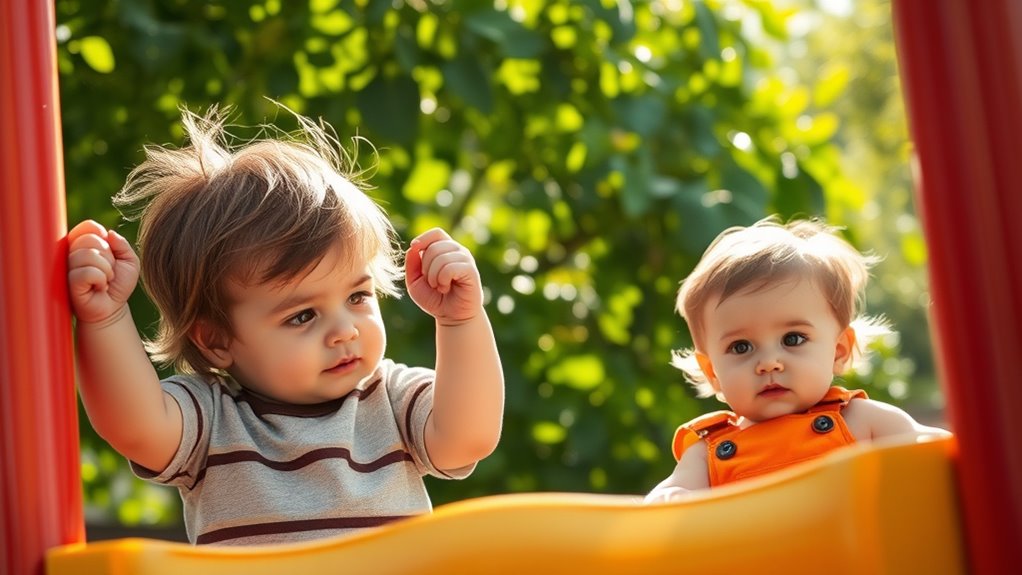
As toddlers become more confident in their mobility, they zealously start climbing and exploring their environment with curiosity. This is a pivotal time for developing balance and coordination, as they learn to navigate stairs, furniture, and other objects. Their muscles strengthen, allowing them to experiment with new movements. Sensory exploration becomes a key part of this stage—touching, feeling, and investigating different textures and surfaces. You might notice your child climbing onto chairs or exploring shelves, driven by a desire to understand their surroundings. Encouraging safe exploration helps build their confidence and motor skills. Remember to supervise closely, providing a safe environment where your little explorer can satisfy their curiosity without unnecessary risks.
Developing Hand-Eye Coordination Through Play

Encouraging your toddler to participate in playful activities can considerably enhance their hand-eye coordination. Sensory play is especially effective, helping them learn to coordinate their vision and movements. Here are four simple activities to try:
Engage your toddler in playful activities like stacking blocks and coloring to boost their hand-eye coordination naturally.
- Stacking blocks – Encourages precise hand movements and spatial awareness.
- Rolling a ball back and forth – Improves timing and coordination.
- Picking up small objects – Develops fine motor skills and hand control.
- Coloring with crayons or markers – Fosters grip strength and visual focus.
These activities make learning fun and help your child strengthen their hand-eye coordination naturally. Remember, consistent, playful practice is key to supporting their development in this area through sensory play.
Establishing Basic Self-Help Skills
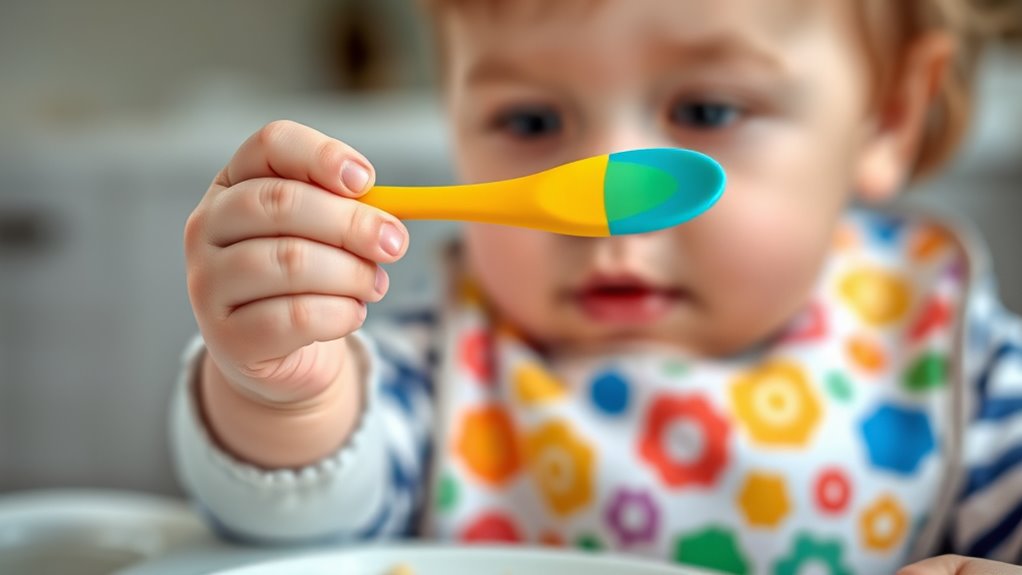
At this stage, helping your toddler develop basic self-help skills lays an important foundation for their independence. You can encourage self-care routines like washing hands, brushing teeth, and dressing. Make routines simple and consistent, so your child learns what to expect. Pay attention to their potty training progress; many toddlers start showing signs of readiness around this time. Offer encouragement and patience as they practice sitting on the potty and wiping themselves. Use positive reinforcement to build confidence. Avoid rushing; each child progresses at their own pace. Gradually, they’ll begin to manage small tasks independently, boosting their confidence and sense of control. Establishing these routines now sets the stage for more advanced self-help skills later on.
Observing Social Interactions and Play Behaviors
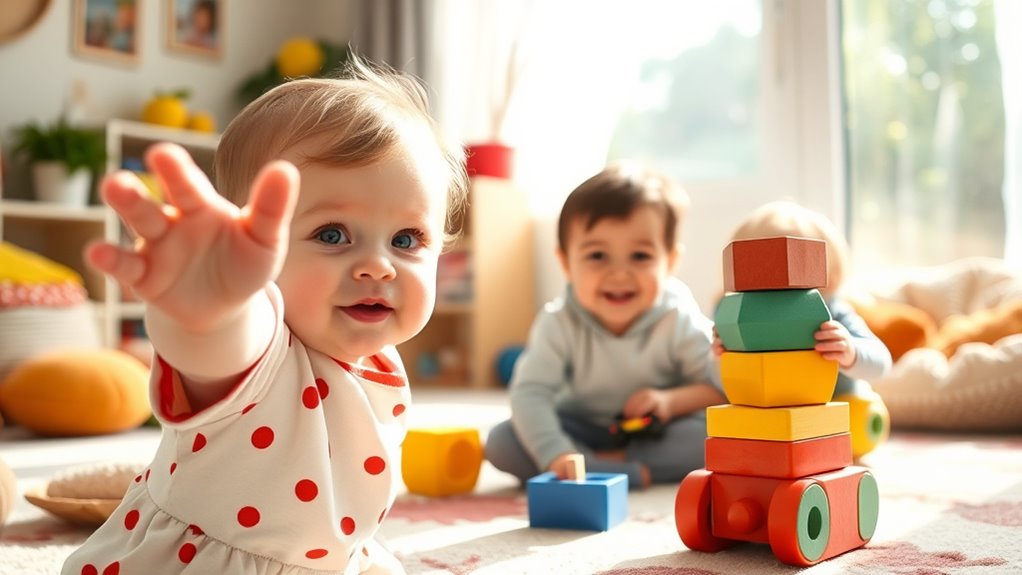
Observing your toddler’s social interactions and play behaviors provides valuable insight into their emotional development and ability to relate to others. At this stage, you’ll notice how they start engaging with peers and developing social skills. Pay attention to how they initiate or respond to play, share toys, or seek comfort from familiar faces. These behaviors reveal their comfort level with peer interactions and emotional awareness.
Here are some signs to look for:
- Your toddler copies actions during play, showing emerging social skills.
- They try to share toys or invite others to join their activities.
- They display interest in other children, approaching or watching them.
- They begin to understand simple social cues, like waving or saying hello.
Frequently Asked Questions
When Should I Be Concerned About Delayed Speech Development?
You should be concerned about speech delays if your child isn’t babbling by around 12 months or isn’t using gestures like pointing or waving. If they aren’t saying single words by 15-18 months or combining words by age 2, early intervention can make a big difference. Trust your instincts and consult a pediatrician if you’re worried, as early help can support better communication skills and development.
How Can I Encourage My Child’s Language Skills at Home?
Imagine it’s 1720 and you’re guiding your child’s language skills. You can encourage growth by singing songs together and reading stories daily. Talk to your child often, describing what you’re doing, and ask simple questions to boost their vocabulary. Use gestures and facial expressions to support understanding. Creating a language-rich environment helps your little one develop speech naturally, making learning fun and engaging at home.
Are There Specific Toys That Promote Early Communication?
Yes, you can promote early communication by choosing interactive toys and storytelling games. Interactive toys that respond to your child’s actions encourage them to use words and sounds, boosting their language skills. Storytelling games help your child practice vocabulary and narrative skills in a fun way. By engaging with these toys regularly, you create an enriching environment that motivates your little one to communicate and explore language naturally.
How Does a Child’s Environment Influence Their Milestones?
Your child’s environment is like a fertile garden where language blossoms and social skills flourish. When you create a language-rich environment filled with varied words, stories, and songs, you plant seeds for early communication. Providing ample social interaction opportunities, like playdates or family gatherings, helps your child practice words and gestures, turning everyday moments into vibrant conversations. Nurture this environment, and watch their milestones bloom with confidence and curiosity.
When Should I Seek Professional Help for Developmental Concerns?
You should seek professional help if your child’s development raises concerns, such as limited speech, poor social interactions, or delays in motor skills, especially after age 18 months. Early intervention is vital, and speech therapy can markedly support your child’s growth. Trust your instincts and consult a pediatrician or specialist promptly to discuss your observations and explore necessary evaluations or therapies to support your child’s milestones.
Conclusion
As you watch your little one hit these incredible milestones, you’ll feel like you’ve uncovered the secrets to a genius in the making! Every new word, smile, and curious climb is a sign that your tiny explorer is transforming the world—one big move at a time. Cherish these moments, because before you know it, they’ll be taking giant leaps into independence. Get ready, because your little superstar is just getting started!
